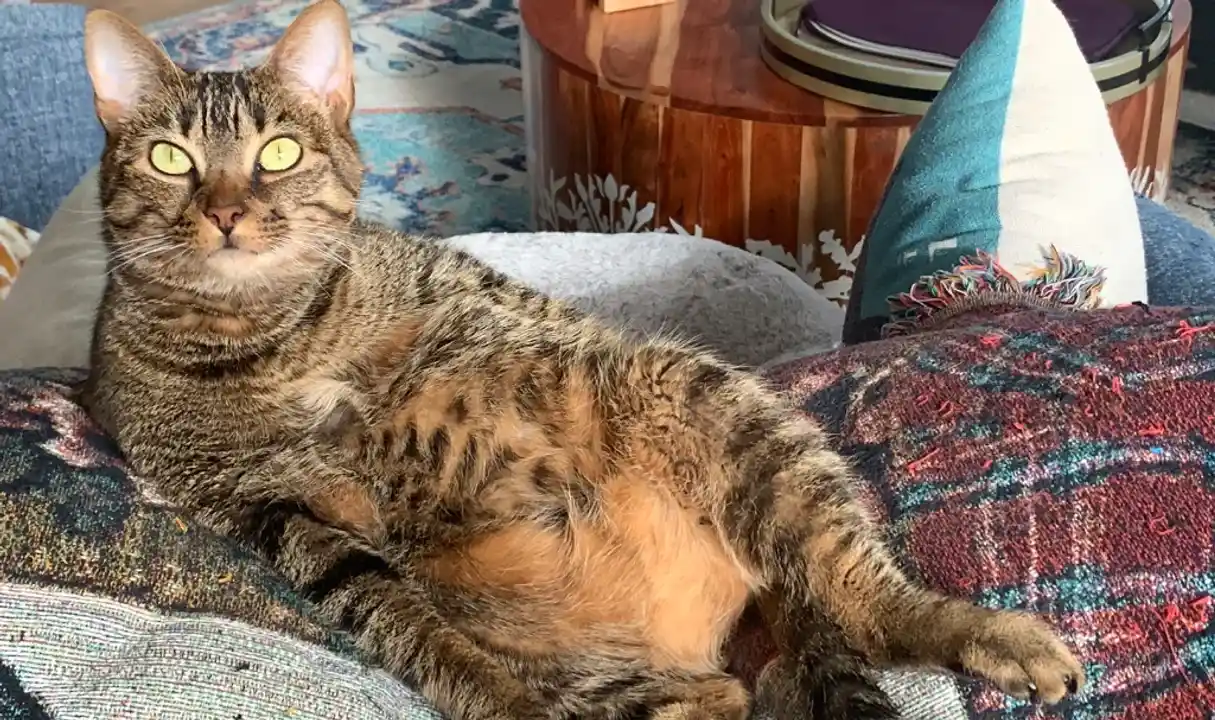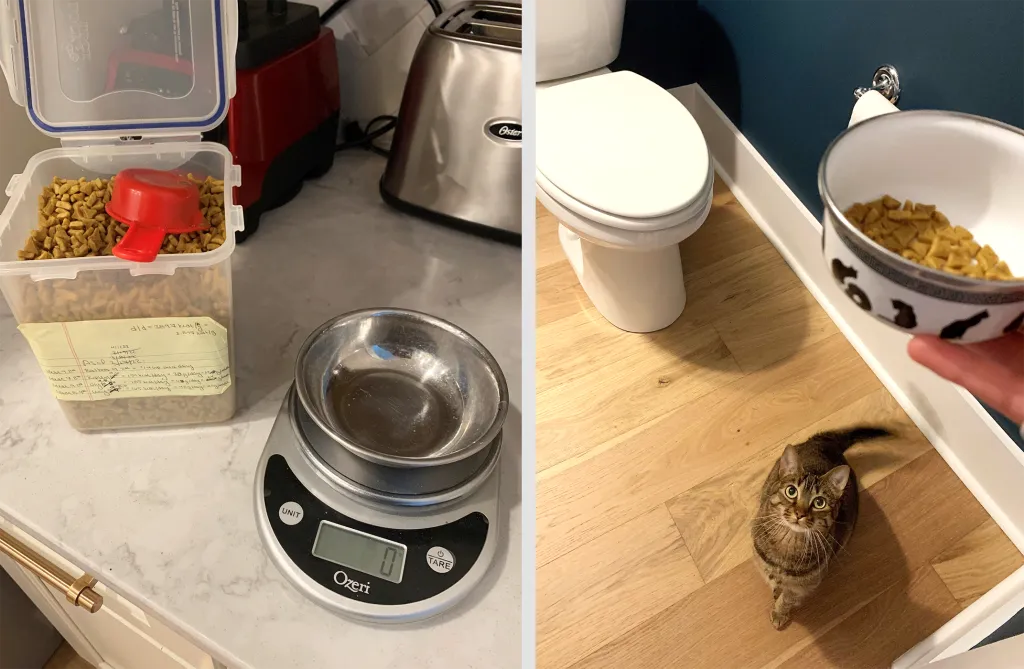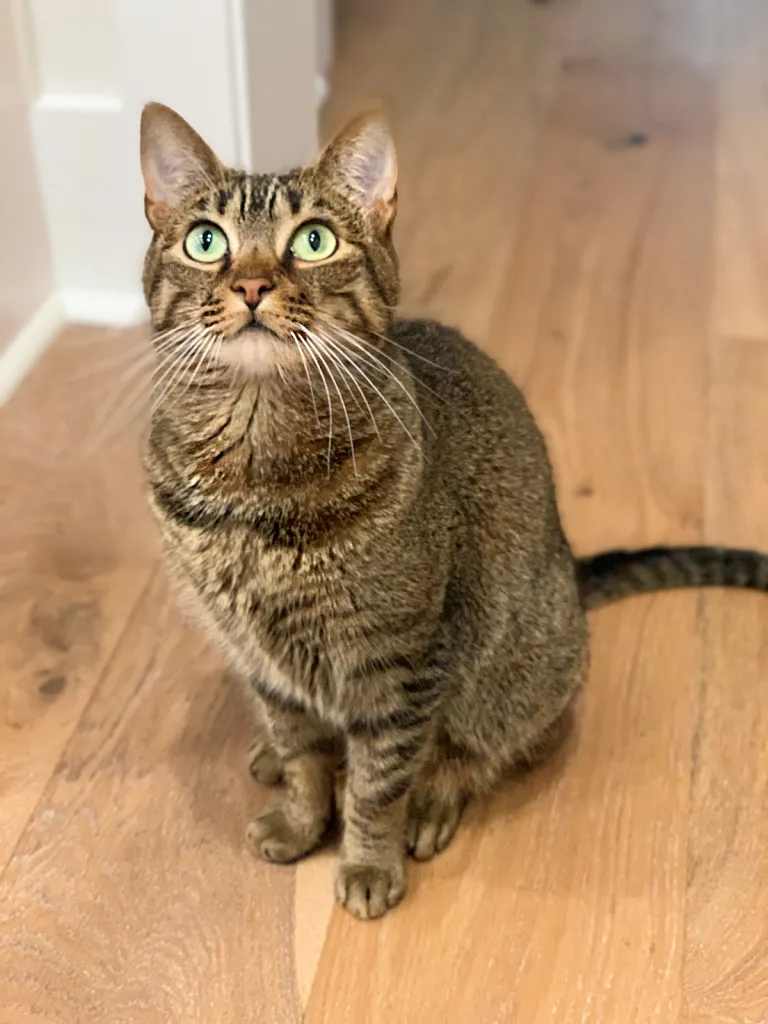The elephant in the room: A veterinarian’s struggle with feline obesity


I vividly remember the day that I realized that most of my precious felines were overweight.
We had come back from a long weekend away to find that our pet sitter had accidentally left out their food bag. Based on the plastic remnants shoved to the bottom of the trash can, it was clear the cats had the time of their lives.
But the sad remains of that bag were not the only evidence of their deed: Ripley, the youngest and naturally the smallest, had lost all definition, her body more akin to an engorged tick than the svelte feline she typically was.
After getting over the frustration of countless dollars of food lost needlessly to greedy gullets, I presumed that Ripley’s body habitus would return to normal within the next few days as her food bloat resolved.
Those days came and went, and Ripley looked the same. When I finally took off my rose-colored glasses and looked critically at my other cats, weighing them and comparing to previous measurements, I realized that all but the geriatric, chronic vomiting cat had gained a substantial amount of weight.
I, a veterinarian who counsels pet owners daily about the dangers of pet obesity, was the owner of multiple overweight to obese cats. Worse, I couldn’t even explain how it happened!
I felt a bit hypocritical: how could I truthfully provide guidance to those who seek my opinion when I had clearly missed the mark with my own pets at home?
More cat content: 5 tips for happily coexisting cats and houseplants
Feline obesity
I know the statistics well: According to the Association for Pet Obesity Prevention, approximately 60% of cats and 56% of dogs were overweight to obese in 2018.
Multiple studies have shown that keeping a pet in lean body condition can add one to two or more years to their life, and we know that the number one thing we can do for our osteoarthritic patients is to keep them thin.
From human data, we can say that fat is pro-inflammatory, and while metabolic conditions do not play out the same way in pets as they do in people, similar principles of inflammation and subsequent downstream consequences still stand.
With an adult human overweight to obese cohort of 74% according to 2018 CDC data, it’s becoming harder and harder to divorce the weight conversation in pets from the emotional impact this can have on their owners, who may also be suffering from similar comorbidities.
Yet clearly, despite understanding all these things myself, I’m not immune to the creep of weight gain in my own pets.
Managing healthy weight in cats
So, what was I missing? When I have the diet talk with pet owners, I ask some basic but very important questions: What brand of food is your pet eating? How much, and how frequently? Are we sure they’re not getting any other pets’ food? When you say “one cup,” is this truly a standard, 8-ounce kitchen cup?
What other things is your pet getting outside of meals? Who is responsible for doing the feeding, and if there are multiple members of the house involved, does everyone communicate about what and how much your pet is getting?
After donning my investigator cap, I realized a few things had gone awry in my home.
Pet food calorie count
First, and most importantly, I hadn’t checked the calories per cup of my cats’ food after the recent reformulation. When I brushed aside the bold, shiny “New and Improved Formula!” sticker, I failed to note the 20% (yes, a full fifth!) caloric increase per serving.
A simple oversight over the course of multiple months had undoubtedly contributed to my cats’ noticeable weight gain.
Serving sizes
The second misstep was a lack of communication between my husband and me about serving size. We had already been feeding them less than a quarter cup per serving; however, it became apparent that my concept of “a little less” was wildly different than that of my husband.
When I started calculating, I realized that our differing perceptions alone contributed to another 10% swing in daily calories.
This spousal miscommunication also extended to what we were giving Ripley’s medication in and how much (as an aside, if you’re looking for a seemingly innocuous topic which can cause an inordinate amount of strife within the home, look no further than what constitutes an “appropriate” amount of peanut butter in which to place your pet’s pills).
“Double-dipping”
Lastly, despite feeding the cats in separate areas of the first floor to avoid any sneaky double dipping, Ripley in particular was still finding a way to steal a mouthful from her siblings.
With such small serving sizes to start, that extra mouthful was adding a few more percentage swing to her daily intake.
Read more: Preventing and treating feline heartworm with Dr. Kelly
Establishing a healthy weight plan
Once I knew where we were falling short, I put a plan in action. I have been a fan of Pet Nutrition Alliance’s weight loss calculators for my clients for some time, so I quickly created individualized calorie and final weight goals for my own three overweight to obese cats.
Where things got a little tricky was figuring out how to hit that specific calorie goal using standard kitchen measuring cups. Cue the kitchen scale.

If you don’t already have one of these, I highly recommend adding one to your stock. Not only are they cheap and readily available (a quick search on Amazon shows an average price of about $11), but they are extremely helpful when calculating very specific quantities, whether in pounds, ounces, or grams, for both cooking and small animal weight loss purposes.
On most canine and feline food bags, the caloric content is written in both kcal/cup and kcal/kg. After calculating how many calories (interchangeable with kcal) there were in each gram of food by dividing the kcal/kg number by 1000, I was able to determine how many grams of food were needed to hit the exact number of calories my stubborn cats should be eating a day. I then wrote this number on a chart which I pasted to the food container so that there would be no confusion about how much each cat needed.
To ensure there are no errors, we both use the same procedure: turn on the scale, place the empty bowl on the scale, tare the weight so it levels to zero, and add food until the desired gram weight is achieved.
To avoid further headache induced by the food bully, we decided to feed Ripley exclusively in a bathroom with the door shut and only release her once the other cats were finished. While this has resulted in a lot of temporary cat yodeling, we have assured her that eating in solitude is for her own good.
Assessing weight gain and weight loss
Just as it can be difficult to appreciate gradual weight gain when we’re looking at our pets or ourselves every day, so too can be said about weight loss. We’ve taken to weighing the cats every few weeks by weighing ourselves holding a cat, then weighing ourselves, and subtracting the difference.
Admittedly, this is not the most precise way to track weight loss in small mammals, but it does allow for monitoring trends. If you want to go big, purchasing a baby scale (ranging from $30-50 on Amazon) is the best way to ensure accuracy.
While all this may seem complicated, I can assure you that the long-term payoff is worth it. An hour of planning and a few extra minutes each day have already resulted in steady weight loss for each cat. While the youngest has been slower to lose than others, I’m happy to say that I can at least see her knees again, and from certain angles in just the right lighting, I can see her waist!
Better yet, I’ve noticed that they are all more active, they snore less, and their various ailments seem easier to control.

In closing
As we learn more about the detrimental effects of carrying excess weight in human medicine, let’s not forget about our canine and feline counterparts, including those as veterinarians in our own home. With a little extra time and effort, we can provide our pets with a better quality of life and prevent disease each day.
Disclaimer: Before embarking on a weight loss journey with your own pet, it’s critically important to first discuss a plan with your veterinarian.
Some pets can have medical conditions that lead to weight gain, and cats in particular are very sensitive to rapid weight loss. Frequent monitoring and follow up with your veterinarian are key to ensuring a weight loss plan is safe and healthy for your pet.
Dr. Jessica Nord is an Associate IndeVet practicing in South Carolina. Picture above is Ripley, looking chonky before her weight-loss journey.
More from IndeVets:
Springtime tips for pet owners: 4 ways to keep your furry friends safe
You’re gonna wanna bookmark this: Our guide to useful veterinary resources
